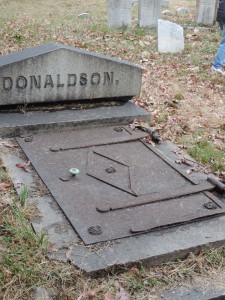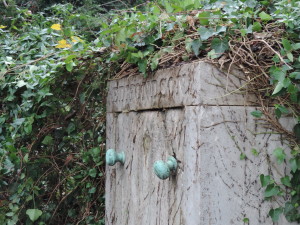If you’re a history buff, at some point you’re probably going to be tromping through an old cemetery. On a recent tour with the Baltimore Heritage Foundation, I finally had the opportunity to explore Old St. Paul’s cemetery. I wouldn’t say I was dying to get in there, but I have always wanted to see inside.
Old St. Paul’s is the final resting place of quite a few famous folks, particularly people from early prominent Baltimore families for whom many streets and buildings in the city are named.
The cemetery is located along some busy streets (Lombard and MLK) and flanked on two sides by buildings of the University of Maryland, Baltimore (more location details “On the Map” page). I am sure thousands of people pass the cemetery’s tall stone walls every day and have no idea what’s behind them. As the sign outside the gate says, Old St. Paul’s is home to the remains of many “illustrious men who assisted in the achievement of National Independence in the Revolution and the War of 1812.” (Yes, the sign says “men,” but the cemetery was founded in 1800, what do you expect).
 The tour took place on a cool, gray fall day – fantastic atmosphere for a cemetery tour – with amazing trees, creeping vines and old headstones. Much of the Old St. Paul’s history has been lost to history. However, our guide said “they” think at least one president visited: John Quincy Adams.
The tour took place on a cool, gray fall day – fantastic atmosphere for a cemetery tour – with amazing trees, creeping vines and old headstones. Much of the Old St. Paul’s history has been lost to history. However, our guide said “they” think at least one president visited: John Quincy Adams.
One famous “resident” is Samuel Chase, signer of the Declaration of Independence and Supreme Court justice. Yes, Baltimore has a Chase Street. According to our guide, some people seek to visit the burial sites of all Declaration’s signers – that’s a nerdy threshold I don’t think I am ready to cross.
Star Spangled Banner author Francis Scott Key was interred at Old St. Paul’s for a time in his in-laws’ family tomb. Key’s daughter was married to the son of John Eager Howard***, who was Maryland governor and is buried in St. Paul’s, and, we have lots of things named for him. (Key’s grave is now located in a cemetery in Frederick, Maryland).
The War of 1812’s General George Armistead is also buried here, famous as Ft. McHenry’s defender who commissioned the fort’s massive flag that inspired our national anthem. Armistead was only 38 when he died, four years after the bombardment.
You might think George Armistead is one of the cemetery’s star attractions, but our guide said that it’s the general’s nephew who gets the most inquiries – Confederate Brigadier General Lewis Armistead who was wounded, captured and died in the Battle of Gettysburg.
As with most cemeteries, there are also some intriguing grave designs. Look at this one with a doorknob, which looks very “Alice in Wonderland” to me. Then there’s one with two knobs.

This grave has a door with a knob. Our guide said the doors often led to staircases taking you to underground vaults.
Here’s a fun footnote. After my visit, I got a message via Twitter from John Gadsby (@JohnGadsby), proprieter of Gadsby’s Tavern in Alexandria, Virginia. There’s also a Gadsby’s Tavern museum that we’ll need to visit.
Mr. Gadsby asked me to say “hello” to his wife Margaret who died in 1812 and is buried in Old St. Paul’s. We actually missed Margaret on the tour, and I am actually somewhat relieved that she didn’t say “hi.” I was amused that I was going back and forth with the tavern, although technically the account is in Gadsby’s name, so I was kind-of tweeting with a dead person (I also missed Gadsby’s vault on a recent trip to Congressional Cemetery. I guess I am zero for two with the Gadsby family!)
For history buffs, try not to be creeped out by tweeting with dead people or tromping through old cemeteries. There’s always something to learn.
**Originally I had posted that John Eager Howard was Francis Scott Key’s father-in-law, and a reader commented to let me the real family connection. I may have misheard the tour guide – my apologies.











 RSS - Posts
RSS - Posts
6 Comments
wineandhistory
December 15, 2013 at 11:55 pm
What a neat cemetery! I love old graveyards – I think they are very peaceful (my husband thinks that’s weird…)
nerdtrips
December 16, 2013 at 11:53 am
I have a growing appreciation for cemeteries. One tour guide said that, in the Victorian era, people used to picnic in cemeteries, I don’t think I am quite there yet, but I do think they are interesting to explore.
thehistorytourist
December 16, 2013 at 11:49 am
I hereby secure my place in the nerd club by being seriously jealous that you got a tweet from Mr. Gadsby.
nerdtrips
December 16, 2013 at 11:54 am
I am sure Mr Gadsby would tweet with you too. Anyone who’s name is thehistorytourist definitely has a secure spot in the nerd club!
John Eager Howard was not Francis Scott Key’s father-in-law. Key’s daughter was married to Howard’s son.
Thank you so much for your comment. It has been a long time since I wrote the post, so I do not recall where I got that information. Maybe I misheard the tour guide. I will update the blog post. My apologies for taking a while to respond, the COVID quarantine has changed my routine. Thanks again.